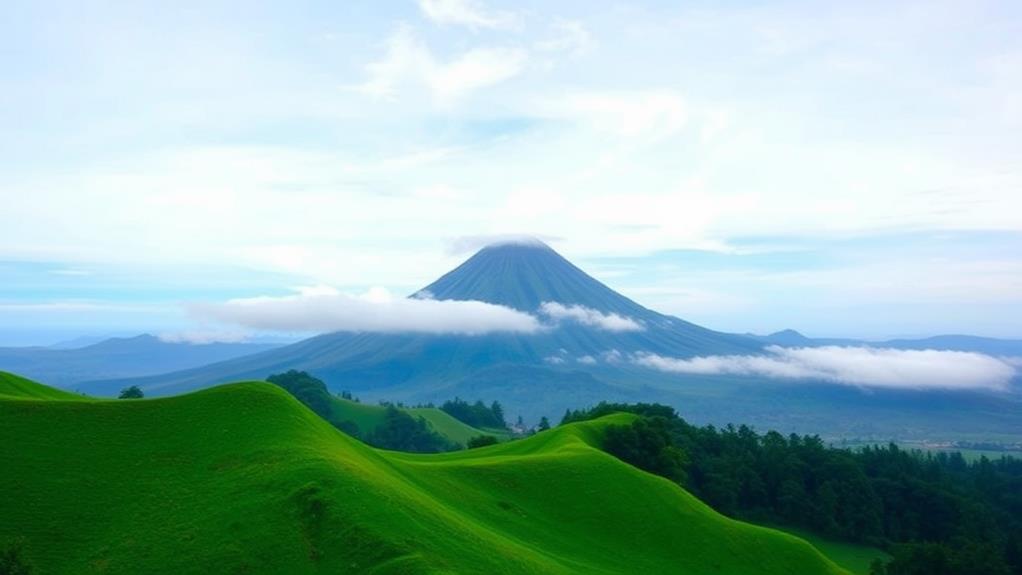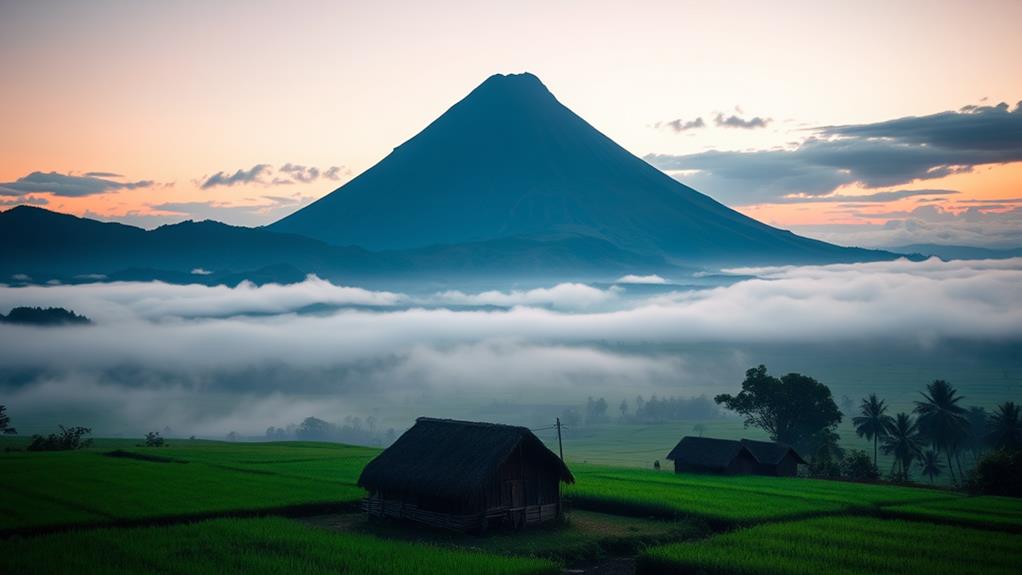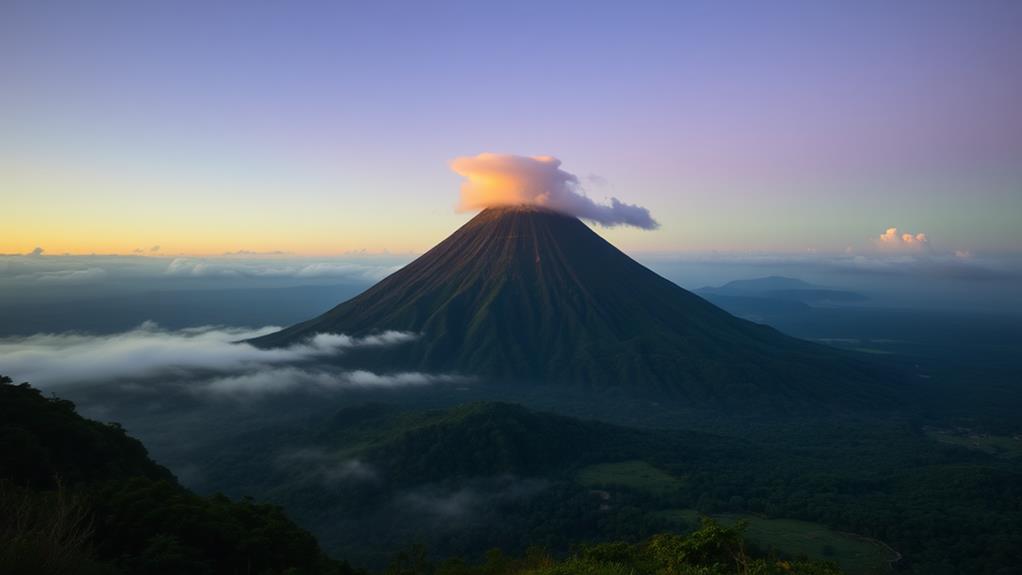Mayon Volcano's Perfect Cone
Mayon Volcano stands 2,462 meters tall, its perfect cone shape a testament to the powerful forces of geology.
The surrounding landscape offers a striking contrast between lush vegetation and rugged volcanic rock.
Capturing the Perfect Shot
To capture Mayon's cone, time your photo shoot between 4 am and 9 am or 4 pm onwards for optimal lighting.
Using a high-quality camera will enhance image quality and detail.
The Cagsawa Ruins provide a historical backdrop for capturing the volcano's majesty.
Uncovering Secrets
As you explore Mayon Volcano, you'll uncover more secrets of this breathtaking natural wonder.
Volcanic Landscape and Geological Significance

Mayon Volcano's Majestic Landscape
Standing at the foot of Mayon Volcano, you're met with a breathtaking landscape. The volcano's near-perfect cone shape is a testament to the powerful geological forces that have shaped it over the centuries. This symmetrical structure is a result of the volcano's complex geological history, characterized by multiple layers of basalt and andesite rock formed through explosive and effusive eruptions.
Volcanic Landscape and Geological Significance
The surrounding landscape is a striking contrast of lush green vegetation and rugged volcanic rock. Mayon Volcano's 2,462-meter elevation makes it one of the tallest volcanoes in the Philippines.
As part of the Pacific Ring of Fire, Mayon's eruptions are a reminder of the region's volatile geological activity. With a documented history of at least 50 eruptions over the past 500 years, Mayon's volcanic landscape is a dynamic and ever-changing wonder.
Capturing the Perfect Shot
Timing is Key
To capture Mayon Volcano's majestic beauty, timing is crucial.
The best moments to take pictures are early morning (4 am – 9 am) and late afternoon (4 pm onwards), when the lighting is optimal and clouds are less likely to obscure your view.
Optimal Vantage Points
Cagsawa Ruins offer a historical backdrop, allowing you to capture Mayon's cone against a historic landscape.
Lignon Hill provides elevated views, perfect for panoramic shots of the volcano and surrounding landscape.
Dried river beds feature unique terrain, ideal for framing Mayon's eruptions and lava flows.
Capturing High-Quality Images
Use a high-quality camera like the NIKON D610 to enhance image quality and capture the intricate details of Mayon's landscape.
Engaging with local guides can also enrich your photographic experience, providing insights into the best spots and times to shoot.
Cultural Significance and Local Folklore

Mayon Volcano holds significant cultural importance in the Bicol region, where it's affectionately known as "Daragang Magayon" or "Beautiful Lady". This nickname reflects the volcano's majestic beauty and the local legends surrounding it.
According to local folklore, Mayon Volcano symbolizes both beauty and danger, as seen in the tale of Daragang Magayon, a beautiful maiden whose story intertwines with the volcano.
The community celebrates Mayon as a symbol of resilience, reflecting how local farmers express both admiration and concern for the volcano's potential eruptions.
Folklore suggests that the appearance of rainbows near Mayon can predict volcanic eruptions, illustrating the blend of traditional beliefs with natural phenomena.
Festivals and cultural events in Albay often highlight Mayon's beauty, reinforcing its status as a beloved icon in Filipino culture and a focal point for artistic expression.
The historic Cagsawa Church stands as a testament to the volcano's power and cultural significance, as it was left indelibly marked by Mayon's past eruptions.
Tourism and Environmental Concerns
Mayon Volcano's Beauty Attracts Millions, But at What Cost?
Standing at the foot of Mayon Volcano, its majestic beauty is undeniable. The volcano's perfect cone shape attracts millions of tourists every year. However, this influx of visitors comes with a price – environmental degradation.
The surrounding ecosystems are at risk of being destroyed.
Conservation Efforts in Progress
Conservation efforts are underway to balance tourism with the preservation of surrounding ecosystems. Guided climbs and eco-tours promote responsible tourism, contributing to the local economy and raising environmental awareness among visitors.
This approach helps to minimize the negative impact of tourism on the environment.
The Community's Livelihood Depends on the Volcano
Local farmers are concerned about the impact of volcanic activity on agriculture. The community's livelihood is deeply connected to the volcano's behavior.
This highlights the importance of sustainable tourism practices to ensure the long-term viability of the local economy.
Sustainable Tourism Practices are Essential
With great beauty comes great responsibility. It's essential to be mindful of the volcano's power and the need for sustainable tourism practices.
Photographic Pursuits and Adventure

Capturing Mayon Volcano's Majesty
As you venture beyond responsible tourism, your camera becomes an essential tool to capture the breathtaking beauty of Mayon Volcano. The volcano's conical shape offers endless opportunities to experiment with unique angles and compositions. To get the best views, you'll need to navigate dried river beds and elevated vantage points, but the effort is well worth it. After a day of exploring Mayon Volcano, take some time to unwind and relax at the nearby beaches. The Philippines is known for its stunning natural landscapes, and Mayon Volcano is just the beginning. Make sure to visit Boracay’s stunning white sand beaches for a truly unforgettable experience. The contrast between the rugged beauty of the volcano and the pristine beaches of Boracay creates a perfect balance for any nature enthusiast.
Golden Hours and High-Quality Cameras
With a high-quality camera like the NIKON D610, you'll be able to capture Mayon's beauty in stunning detail, particularly during the golden hours of sunrise and sunset. These times offer the best lighting conditions to highlight the volcano's majestic features.
Adventure Tourism and Photography
Adventure tourism around Mayon offers a range of exciting opportunities to explore diverse terrains while capturing the volcano's majesty. Guided climbs and ATV rides take you off the beaten path, allowing you to experience the thrill of photography in rugged landscapes.
Popular photography spots like the Cagsawa Ruins offer a striking contrast between historical structures and the volcanic backdrop, especially during significant eruptions.
Mayon's Beauty and Adventure
Mayon's beauty is more than just a visual feast – it's an adventure that will leave you breathless. As you embark on this photographic journey, you'll find that the volcano's majesty isn't just about capturing stunning images, but also about experiencing the thrill of adventure in the midst of rugged landscapes.
What Makes Mayon Volcano’s Perfect Cone Different from Other Volcanoes?
Mayon Volcano’s perfect cone sets it apart from other volcanoes. The symmetry and steepness of its slopes make it stand out, unlike Camiguin’s natural attractions. This iconic shape is due to its lava flow and ash deposits over time, creating a striking silhouette that is unique to Mayon.
Conservation and Community Response
Beyond the lens of your camera, a deeper story unfolds around Mayon Volcano, one of delicate balance and community resilience.
Conservation Initiatives Balance Tourism with Environmental Preservation
Conservation efforts are in place to protect surrounding ecosystems while promoting eco-tourism development. Reforestation programs and habitat preservation initiatives are key to preserving the environment.
Additionally, waste management systems and environmental education programs raise awareness about the importance of conservation.
Local Communities are Actively Involved in Disaster Preparedness
Local communities are actively involved in disaster preparedness efforts to ensure safety during volcanic eruptions. Evacuation plans are in place, and evacuation drills are conducted regularly.
Rainfall monitoring and seismic activity tracking help predict volcanic activity, enabling the community to respond effectively.
Traditional Knowledge and Modern Monitoring Systems Complement Each Other
The community blends traditional knowledge with modern monitoring systems to respond to volcanic activity. For example, the local folklore belief that rainbows near Mayon predict eruptions is combined with eruption prediction models and gas emission monitoring to ensure a comprehensive understanding of the volcano's activity.
Community-based monitoring and agricultural contingency plans also play a crucial role in the community's response to volcanic activity.
Frequently Asked Questions
Why Is Mayon Volcano a Perfect Cone?
Mayon Volcano's unique shape is due to its volcanic symmetry. This symmetry has resulted from the accumulation of layers of lava and ash deposits, which have built up around the volcano's vent.
Over time, these deposits have formed a steep, conical structure.
The volcano's shape isn't only aesthetically pleasing but also culturally significant. The natural forces that have sculpted Mayon Volcano over time have made it a true marvel of the natural world.
How Many People Died in the Mayon Volcano Eruption 2018?
Zero people died during the 2018 Mayon Volcano eruption, thanks to effective disaster preparedness and evacuation measures by local authorities.
This successful outcome was a result of the region's experience with volcanic activity and the importance of staying vigilant.
Although there were no fatalities, the eruption still had a significant impact. It disrupted air quality, agriculture, and daily life for thousands of people.
During the evacuation process, some injuries occurred due to ash falls.
What Is the Story Behind the Volcano Mayon?
The Majestic Mayon Volcano Has a Rich History
Mayon Volcano's perfect cone shape has a fascinating story behind it. The volcano has experienced numerous historical eruptions, including the devastating 1814 event that destroyed the Cagsawa Ruins. This eruption was so powerful that it buried the town of Cagsawa under volcanic ash and debris, leaving only the bell tower standing.
Local Legends Surround the Volcano
The volcano is also steeped in local legends, such as the "Beautiful Lady" narrative. This legend tells the story of a beautiful maiden who was turned into a volcano by the gods as punishment for her disobedience.
These stories weave a cultural tapestry around the volcano, showcasing its significance in the local community.
Geological Formation Shapes the Volcano's Iconic Shape
Mayon Volcano's unique shape is composed of basalt and andesite rocks, which have been formed over thousands of years.
The combination of these rocks has shaped the volcano's iconic cone shape, making it a distinctive landmark in the region.
Cultural Significance Extends Beyond Natural Beauty
Mayon Volcano's cultural significance extends beyond its natural beauty, influencing the identity of the surrounding communities.
The volcano is a symbol of the region's history, culture, and resilience, and its impact is felt in the daily lives of the people who live nearby.
What Are 5 Interesting Facts About the Mayon Volcano?
Mayon Volcano has erupted over 50 times in the last 500 years. This intense volcanic activity has shaped the local culture, with the volcano playing a significant role in the legend of Daragang Magayon.
Mayon Volcano is a stratovolcano composed of basalt and andesite rocks. This unique composition has resulted in its perfect cone shape, a rare geological feature.
The volcano's environmental impact is significant. Ash clouds and evacuations are common consequences of its eruptions, posing a threat to the surrounding environment and local communities.
Mayon Volcano is both beautiful and dangerous. Its captivating landscape and powerful eruptions make it a fascinating subject to learn about, with a delicate balance between natural wonder and potential destruction.